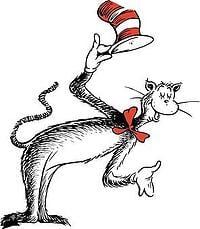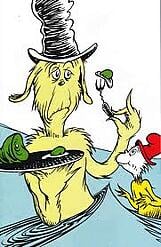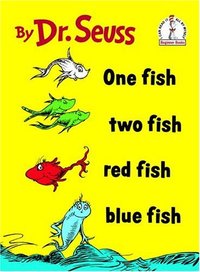You’ve all heard of Theodor Seuss Geisel, though you probably recognize him by his pen name: Dr. Seuss. From “Horton Hears a Who” to “The Grinch Who Stole Christmas,” he wrote in such a way that he kept his readers entertained from start to finish and that’s no easy feat. We owe Dr. Seuss a lot of credit as he taught most of us how to read, rhyme and use our imagination. But we ought to give him credit for teaching us how to be better advertisers because he did that, too. Outlined below are just a few lessons we can learn from his Seussical stories.
The Cat in the Hat
 The Cat in the Hat is by far one of his most popular works. In fact, every book written by Dr. Seuss is branded with an image of that darn cat, so brand awareness is one of his strong suits. This just reinforces the importance of putting your mark on your messaging. You put a lot of time and money into your company logo and tagline, so use them. The Cat in the Hat introduces Sally and her unnamed brother to their imagination one rainy day. Does he need to pay you a visit? Using your imagination is a must when creating ads and striving to reach your advertising goals; however, don’t let it get out of control to the point where it creates a mess, similar to what happened in this story. Long story short: Keep Thing 1 and Thing 2 at bay.
The Cat in the Hat is by far one of his most popular works. In fact, every book written by Dr. Seuss is branded with an image of that darn cat, so brand awareness is one of his strong suits. This just reinforces the importance of putting your mark on your messaging. You put a lot of time and money into your company logo and tagline, so use them. The Cat in the Hat introduces Sally and her unnamed brother to their imagination one rainy day. Does he need to pay you a visit? Using your imagination is a must when creating ads and striving to reach your advertising goals; however, don’t let it get out of control to the point where it creates a mess, similar to what happened in this story. Long story short: Keep Thing 1 and Thing 2 at bay.
Green Eggs and Ham
In this tale, Sam-I-Am struggles to get the narrator to eat green eggs and ham. He refuses them repeatedly saying, “I do not like green eggs and ham. I do not like them Sam-I-Am.” Now, just change “ham” to a more processed form of meat and you’ve got a story to which we all can relate: Green Eggs and Spam. Now we all know spam is bad; it’s formally defined as “unsolicited usually commercial email sent to a large number of addresses.” To be successful advertisers and marketers, we cannot be spammers. When you target your audience you increase the effectiveness of your ads while at the same time refrain from spamming the masses. Remember, the Dr. prescribed ham, not spam, so advertise accordingly. Put yourself in your prospects’ shoes: You would not like spam here or there. You would not like spam anywhere.
One Fish, Two Fish, Red Fish, Blue Fish
 There’s no false advertising in the title of this book. With a quick glance you know exactly what the book is going to be about. (Note: I’m not advocating that you judge a book by its cover.) Don’t be misleading. Use your ad messaging to tell your audience exactly what benefits they will receive if they start using your product or service and how soon they can expect results. Failure to do so is unethical and oftentimes illegal. Use Seuss’s example and tell your customers exactly how many fish they will receive and the color of said fish, if applicable.
There’s no false advertising in the title of this book. With a quick glance you know exactly what the book is going to be about. (Note: I’m not advocating that you judge a book by its cover.) Don’t be misleading. Use your ad messaging to tell your audience exactly what benefits they will receive if they start using your product or service and how soon they can expect results. Failure to do so is unethical and oftentimes illegal. Use Seuss’s example and tell your customers exactly how many fish they will receive and the color of said fish, if applicable.
Oh! The places you'll go if you adopt these advertising best practices. “You’ll be on your way up. You’ll be seeing great sights. You’ll join the high fliers who soar to high heights.” So pick up your tattered copy of “The Lorax” or “Yertle the Turtle” for inspiration and modify your advertising practices with Seuss in mind. If anything, his stories will get your creative juices flowing once again. Speaking of new ideas, you should consider avoiding advertising contracts altogether. Take a look at our eBook “The CMO’s Guide to Non-Contractual Advertising” to learn about the benefits of this non-traditional advertising approach. Otherwise "The CMO's Guide to Integrating Print and Digital Media" is another good read.
Hannah Hill is a marketing specialist at Mediaspace Solutions. Her marketing experience includes writing, inbound marketing, social media and event management. You can connect with Hannah on LinkedIn, Facebook or Google+.






